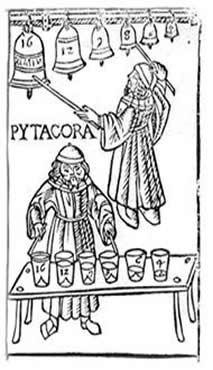Decem Perfectum (2002)
Concertino for Woodwind Quintet, Brass Quintet and Wind Ensemble
Duration: 18 minutes
4(pic)3(eh)4(bcl)3(cb)/4sax/4431/timp.3perc/stbass
Commissioned by a consortium of wind bands
Premiere Performance: Arizona State University Wind Symphony,
Gary W. Hill, Conductor;
College Band Directors National Association conference, Minneapolis;
March 27, 2003
A dazzling showpiece for woodwind quintet, brass quintet and wind ensemble
Pythagoras. Gaffurius, Theoria Musices, Milan 1492

Program Note:
The Latin title, literally “Perfect Ten,” refers to the philosophy of Pythagoras, the 6th-century Greek mathematician. Pythagoras considered the number ten to be a mystical number because it represented the sum of the first four digits: one plus two plus three plus four. Musically, those numbers are significant because they represent the perfect whole-number ratios between pitches comprising the unison (1:1), the octave (2:1), the fourth (3:2) and the fifth (4:3). The pitch material for Decem Perfectum is built primarily upon these perfect intervals. The music is constructed in sets of ten pitches presented in two rhythmic groups of five. Similarly, the ten soloists are divided into two groups: a woodwind quintet of flute, oboe, clarinet, alto saxophone and bassoon and a brass quintet of two trumpets, horn, tenor/bass trombone and tuba.
The first movement, Ritornello, is modeled on the Baroque concerto grosso in which the two groups of soloists alternate with the full ensemble with statements and variations of the principal thematic material. The second movement, Cadenza, features each of the ten soloists in turn, with each new instrument often overlapping its predecessor in a gradual transformation of timbre, register and figuration. The third movement, Toccata, is a vigorous moto perpetuo on a single harmonic pattern in the manner of a Baroque chaconne, in which the forces gradually build in variations of increasing dynamic intensity and richness of texture, culminating in a brilliant climax. The music embodies Rodríguez’ characteristic “richly lyrical” (Musical America) style, which is “romantically dramatic” (Washington Post) and filled with the composer’s “all-encompassing sense of humor” (Los Angeles Times).